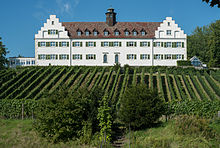Hersberg Castle
Hersberg Castle was a representative monastery branch of the imperial abbey of Ochsenhausen and then a princely estate in the area of the municipality of Immenstaad on Lake Constance . The building is now used as an educational facility for the Pallottine Community.

location
Hersberg Castle is a building complex that can be seen from afar on a hill of the same name overgrown with vines. It is located about 500 meters from the shores of Lake Constance in the west of Immenstaad between Friedrichshafen and Meersburg in the Lake Constance district . Immediately to the west of the Hersberg, the Drumlin Hochberg rises , a striking vantage point, 55 meters above Lake Constance. Below, in the direction of Hagnau , is Kirchberg Castle , formerly the summer residence of the Salem abbots and then owned by the Margrave of Baden .
history
The Lords of Hersberg Castle
The name Hersberg is probably derived from the Old High German word stem hari / heri for mountain range. The first unsecured written reference is a mention of the brothers Berctoldus and Heinricus von Herisberg in 1276. What is certain is that Hersberg was in the fief of the Überlingen citizen and later Fürstenberg vassal Konrad Rudolf von Härsberg in 1466. In 1621 the Benedictines of the Ochsenhausen monastery bought the Hersberg from Härsberg's descendants. After the secularization in 1803, the monastery property fell to Prince Franz Georg Karl von Metternich , father of the Austrian Minister of State, Prince von Metternich . Thereafter Hersberg was bought by the House of Württemberg in 1806 and by Count Konstantin Fürst von Salm-Reifferscheidt in 1838. In 1929, his descendants sold the castle property to the southern German Pallottine Province, which hosted the late career seminar “St. Josef-Hersberg ”with school operations. In 1994 it was reopened as the Pallottine Spiritual House.
Hersberg Castle during National Socialism from 1933 to 1945
In the early years of the Nazi regime, the religious order only suffered from a shortage of young people. In 1940 the house and the school were ordered to be closed. In the last days of the war in April 1945 high defenders were officers , German officers in connection with the assassination attempt on 20 July 1944 on Hitler as well as part of the Action grid in Sippenhaftung imprisoned members taken in the chapel under death threat. Under dramatic circumstances they were hidden from the SS and rescued. After the war, Hersberg Castle became quarters for 200 internees and then French barracks until 1947 . Both of these had negative consequences for the buildings, parks and brothers who were only able to reopen the school afterwards.
Building history of Hersberg Castle
The current appearance of the palace from the south dates from around 1600: a stately 44-meter-wide frontal building with a Belvedere turret in the middle, left and right side wings with Gothic stepped gables , framed by old trees. The oldest part of the building (before 1551) in the northeast was integrated into the building. In 1670, work began on completing the Carré, which was open to the north, with its utility building, torkel and house chapel, which was not completed until 1696. Abbot Alphons planned a representative residential palace for the monastery branch in Hersberg. In 1740 the prelate's room was given a rococo stucco ceiling . It was not until the 20th century that major construction work began again for the school, educational institution and nursing home, but this did not significantly change the impression from the south.
Web links
- Site of the Pallottines of St. Josef - Hersberg
- Liberation of the clan prisoners
- Schloss Hersberg on the website of the Heimatverein Immenstaad e. V.
literature
- Heinz Finke and Wolfram Vogel: Being close to the lake. Palaces, castles, country manors around Lake Constance. Rosgarten Verlag, Konstanz 1991, ISBN 3-87685-129-7 , pp. 210-215.
- Karl Hofer: On the building history of Hersberg Castle . In: Immenstaader Heimatblätter, volume 5. Ed .: Immenstaader Heimatverein. 1981, pp. 10-19.
- Pallottine Community Sankt Josef (Ed.): Hersberg. 1929 / 30–2005. Castle, seminar, advanced high school, educational center. The Pallottines in Immenstaad on Lake Constance. Eppe Verlag, Bergatreute 2005, ISBN 3-89089-404-6 .
- Wolfgang Trogus: The Rudolf von Hersberg family. In: Immenstaader Heimatblätter, issue 1. Ed .: Immenstaader Heimatverein. 1978, pp. 44-47.
- Markus Weßbecher: Hersberg and the Wehrmacht Fortress Detention Center Küstrin. In: Immenstaader Heimatblätter, No. 10. Ed .: Immenstaader Heimatverein. 1986, pp. 72-77.
- Markus Weßbecher: Hersberg Castle on Lake Constance. In: Immenstaader Heimatblätter, issue 19. Ed .: Immenstaader Heimatverein. 2003, pp. 151-170.
- Martin Zürn: Hersberg Castle. From a manor to an educational establishment. In: Immenstaad. History of a maritime community. Ed .: Eveline Schulz, Elmar L. Kuhn , Wolfgang Trogus on behalf of the Immenstaad municipality. Stadler Verlagsgesellschaft, Konstanz 1995, ISBN 3-7977-0313-9 , pp. 399-414.
References and comments
- ^ Martin Zürn: Hersberg Castle. From manor to educational establishment , p. 399
- ↑ See territorial features in southwest Germany after 1810 # Württemberg exclaves
- ↑ Among them was General Hans Speidel , who was active in the First and Second World Wars. He held the highest positions in the Bundeswehr and NATO.
- ↑ Until the approach of the Allies you had been imprisoned in the Wehrmacht fortress detention center Küstrin on the Oder.
- ↑ Markus Weßbecher: Hersberg and the Wehrmacht Fortress Detention Center Küstrin . In: Immenstaader Heimatblätter, No. 10, pp. 72–77. See also Küstrin # Küstrin Fortress (old town)
- ^ Karl Hofer: On the building history of Hersberg Castle . In: Immenstaader Heimatblätter, issue 5, p. 12
Coordinates: 47 ° 39 '59 " N , 9 ° 21' 15.4" E